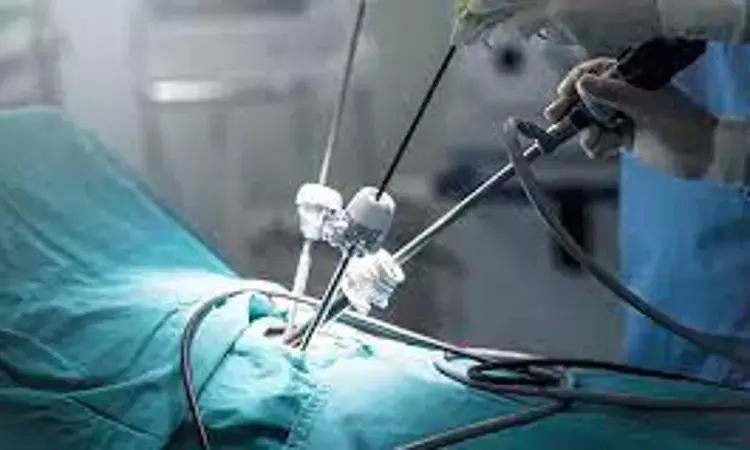- Home
- Medical news & Guidelines
- Anesthesiology
- Cardiology and CTVS
- Critical Care
- Dentistry
- Dermatology
- Diabetes and Endocrinology
- ENT
- Gastroenterology
- Medicine
- Nephrology
- Neurology
- Obstretics-Gynaecology
- Oncology
- Ophthalmology
- Orthopaedics
- Pediatrics-Neonatology
- Psychiatry
- Pulmonology
- Radiology
- Surgery
- Urology
- Laboratory Medicine
- Diet
- Nursing
- Paramedical
- Physiotherapy
- Health news
- Fact Check
- Bone Health Fact Check
- Brain Health Fact Check
- Cancer Related Fact Check
- Child Care Fact Check
- Dental and oral health fact check
- Diabetes and metabolic health fact check
- Diet and Nutrition Fact Check
- Eye and ENT Care Fact Check
- Fitness fact check
- Gut health fact check
- Heart health fact check
- Kidney health fact check
- Medical education fact check
- Men's health fact check
- Respiratory fact check
- Skin and hair care fact check
- Vaccine and Immunization fact check
- Women's health fact check
- AYUSH
- State News
- Andaman and Nicobar Islands
- Andhra Pradesh
- Arunachal Pradesh
- Assam
- Bihar
- Chandigarh
- Chattisgarh
- Dadra and Nagar Haveli
- Daman and Diu
- Delhi
- Goa
- Gujarat
- Haryana
- Himachal Pradesh
- Jammu & Kashmir
- Jharkhand
- Karnataka
- Kerala
- Ladakh
- Lakshadweep
- Madhya Pradesh
- Maharashtra
- Manipur
- Meghalaya
- Mizoram
- Nagaland
- Odisha
- Puducherry
- Punjab
- Rajasthan
- Sikkim
- Tamil Nadu
- Telangana
- Tripura
- Uttar Pradesh
- Uttrakhand
- West Bengal
- Medical Education
- Industry
Ingestion of fish bones leading to gastric perforation and liver abscess formation: Case study

A rare case of Ingestion of fish bones leading to gastric perforation and inducing abscess formation in the caudate lobe of the liver which was successfully treated by laparoscopy was published in the BMC Surgery
The presence of foreign materials on or in the liver is uncommon. In general, most ingested foreign bodies pass smoothly through the gastrointestinal (GI) tract. Less than 1% of patients with intestinal perforation have perforation due to foreign bodies. Endoscopy may be helpful if performed before foreign body migration and mucosal healing. US and CT may help in the diagnosis and treatment planning of these unusual foreign bodies. In China, many foreign bodies may cause severe perforation, including toothpicks, fish bones, dates, and chicken bones
Case presentation
A 67-year-old man presented to our hospital with a 2-day history of subxiphoid pain. There were no specific symptoms other than pain. Laboratory tests showed only an increase in the number and percentage of neutrophils. Contrast-enhanced Computerized tomography (CT) of the abdomen showed two linear dense opacities in the gastric cardia, one of which penetrated the stomach and was adjacent to the caudate lobe of the liver, with inflammatory changes in the caudate lobe. We finally diagnosed his condition as a caudate lobe abscess secondary to intestinal perforation caused by a fishbone based on the history and imaging findings. The patient underwent 3D laparoscopic partial caudate lobectomy, incision and drainage of the liver abscess, and fishbone removal. The procedure was successful and we removed the fishbone from the liver. The patient was discharged on the 9th postoperative day without other complications.
Thus, the researchers concluded that liver abscess caused by foreign bodies requires multidisciplinary treatment. Especially when located in the caudate lobe, one must detect and remove the cause of the abscess as early as possible. Foreign bodies that perforate the gastrointestinal tract can penetrate to the liver and cause abscess formation, as in this case. When exploring the etiology of liver abscesses, one should investigate the general condition, including the whole gastrointestinal tract.
Reference:
Liver abscess in the caudate lobe caused by a fishbone and treated by laparoscopy: a case report by Feng Xia, Peng Zhu et al. published in the BMC Surgery.
https://bmcsurg.biomedcentral.com/articles/10.1186/s12893-021-01457-z
Dr. Shravani Dali has completed her BDS from Pravara institute of medical sciences, loni. Following which she extensively worked in the healthcare sector for 2+ years. She has been actively involved in writing blogs in field of health and wellness. Currently she is pursuing her Masters of public health-health administration from Tata institute of social sciences. She can be contacted at editorial@medicaldialogues.in.
Dr Kamal Kant Kohli-MBBS, DTCD- a chest specialist with more than 30 years of practice and a flair for writing clinical articles, Dr Kamal Kant Kohli joined Medical Dialogues as a Chief Editor of Medical News. Besides writing articles, as an editor, he proofreads and verifies all the medical content published on Medical Dialogues including those coming from journals, studies,medical conferences,guidelines etc. Email: drkohli@medicaldialogues.in. Contact no. 011-43720751


